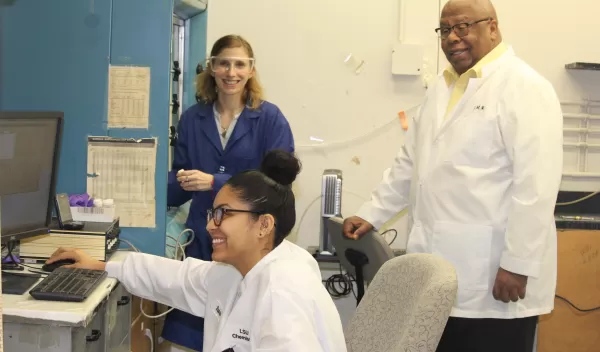
Remarkable ‘electronic nose’ could sniff out nerve gas and rotten foods simultaneously
During Black History Month, the National Science Foundation (NSF) asks the question: Which black scientists are poised to transform their field of research, or society? Analytical and environmental chemist Isiah Warner of Louisiana State University (LSU) is an example of an NSF-supported researcher working to do both.
For nearly 40 years, Warner's research has focused on fluorescence spectroscopy, a scientific method for studying how molecules interact with light in solutions such as a gas or liquid. Now, Warner and a team of LSU researchers are developing a new class of "electronic nose" that can more accurately detect hidden health, security and environmental concerns by simultaneously distinguishing and identifying the multiple volatile organic compounds (VOCs) that cause odors.
A freshly peeled orange has a distinctive odor. Other objects and even some medical conditions are also associated with distinctive odors. For example, the nitroglycerin fumes in dynamite can smell like banana, while food infected with salmonella bacteria can release hydrogen sulfide gas that smells like rotten eggs. The sweat from people suffering from schizophrenia may smell like vinegar.
These odors may help security personnel detect hazardous materials or explosives like dynamite. But what happens if dynamite is hidden amongst oranges? Could an electronic nose distinguish between multiple sources when the VOC mixture is complex?
Warner's answer uses a group of uniform materials based on organic salts (GUMBOS) to detect multiple VOCs simultaneously. By using GUMBOS with a tool called a quartz crystal microbalance, Warner's research team developed an enhanced capability to measure the amount and mass of molecules causing specific odors and identify the substances.
The technology could be useful for sniffing out environmental contaminants, petrochemicals, food contaminants, explosive vapors and disease biomarkers, among other hazardous materials. For example, the devices could be deployed in military clothing to provide real-time monitoring of volatile materials, such as nerve gas agents or other toxic vapors.
"It is possible to miniaturize this device for mobile use in less attractive environments than the laboratory," Warner says. "We believe that our studies will ultimately provide a very sophisticated electronic nose for determining and recognizing complex mixtures of VOCs."
Warner holds the highest professorial rank in the LSU system as a Boyd Professor. He is also the Philip W. West professor of analytical and environmental chemistry, and recently was named 2016 Southeastern Conference professor of the year.
Warner, who has served as principal or co-principal investigator on numerous NSF awards, has published more than 350 refereed publications in a variety of journals and conducted educational research focused on maintaining and enhancing student education in science, technology, engineering and mathematics. In 1997, Warner received the nation's highest award for exceptional STEM mentoring -- the Presidential Award for Excellence in Science, Mathematics and Engineering Mentoring (PAESMEM) award. NSF administers the award on behalf of the White House.


